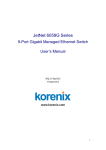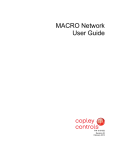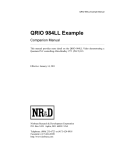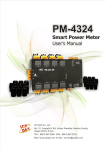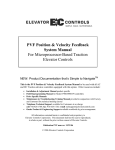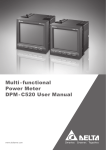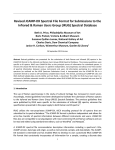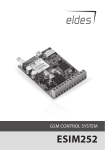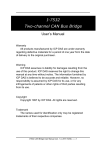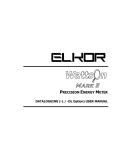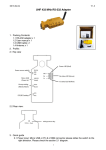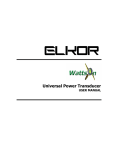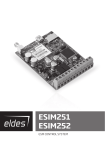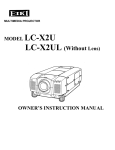Download Installation Considerations Installation and maintenance of the i
Transcript
Installation Considerations Installation and maintenance of the i-Spy device should only be performed by qualified, competent personnel who have appropriate training and experience with high electrical circuit installations. The i-Spy device must be installed in accordance with all Local and National Electrical Safety Codes. WARNING Failure to observe the following may result in severe injury or death: • With their primary circuit energized, current transformers (CTs) may generate high voltage when their secondary windings are open. Follow standard safety precautions while performing any installation or service work (i.e. remove line fuses, short CT secondaries, etc). • This device is not intended for protection applications. • Do not HIPOT and/or dielectric test any of the digital outputs. • Do not exceed rated input signals as it may permanently damage the meter. • The power supply input should be connected via a rated 12-30 VAC/VDC power supply and properly isolated from the line voltage. • Isolation is provided by the current transformers. Limitation of Liability Elkor Technologies Inc. (“Elkor”) reserves the right to make changes to its products and/or their specifications without notice. Elkor strongly recommends obtaining the latest version of the device specifications to assure the most current information is available to the customer. Specifications and manual are available at http://www.elkor.net Elkor assumes no liability for applications assistance, customer’s system design, or infringement of patents or copyrights of third parties by/or arising from the use of Elkor’s devices. ELKOR TECHNOLOGIES INC. SHALL NOT BE LIABLE FOR CONSEQUENTIAL DAMAGES SUSTAINED IN CONNECTION WITH ELKOR PRODUCTS, EXCEPT TO THE EXTENT PROHIBITED BY APPLICABLE LAW. FURTHERMORE, ELKOR NEITHER ALLOWS NOR AUTHORIZES ANY OTHER PERSON TO ASSUME FOR IT ANY SUCH OBLIGATION OR LIABILITY. Although the information contained in this document is believed to be accurate, Elkor assumes no responsibility for any errors which may exist in this publication. ELKOR TECHNOLOGIES INC. - Page 1 - i-Spy – USER MANUAL TABLE OF CONTENTS 1. Introduction .............................................................................................................................................. 3 1.1. Electrical Wiring ................................................................................................................................................3 1.2. Documentation .................................................................................................................................................3 1.3. Disclosure.........................................................................................................................................................3 1.4. Warranty ..........................................................................................................................................................3 1.5. Product Description ...........................................................................................................................................3 1.6. Features ...........................................................................................................................................................3 2. Specifications ............................................................................................................................................ 4 2.1. Environmental ..................................................................................................................................................4 2.2. Power Supply Requirements ..............................................................................................................................4 2.3. Current Input Requirements (model-dependant) .................................................................................................4 2.4. Indicators .........................................................................................................................................................5 2.5. Digital Communication ......................................................................................................................................5 2.6. Update Frequency.............................................................................................................................................5 2.7. Accuracy Specification .......................................................................................................................................6 3. Installation................................................................................................................................................ 7 3.1. Setting the Modbus Address ..............................................................................................................................7 4. Communication ......................................................................................................................................... 8 4.1. Modbus Protocol ...............................................................................................................................................8 4.2. Modbus Functions .............................................................................................................................................8 5. Register Map ........................................................................................................................................... 11 5.1. Register Addressing Conventions .....................................................................................................................11 5.2. Data Types .....................................................................................................................................................11 5.3. Read-only and Read/Write Registers ................................................................................................................11 5.4. Data Registers ................................................................................................................................................11 5.5. Scaling Registers.............................................................................................................................................14 5.6. Configuration and Status Registers...................................................................................................................15 5.7. System Registers ............................................................................................................................................18 6. Customizing the Register Map ................................................................................................................ 20 7. Firmware Updates and the Bootloader ................................................................................................... 22 8. Appendix A, Modbus Protocol Details ..................................................................................................... 23 8.1. Modbus Frames ..............................................................................................................................................23 8.2. Cyclic Redundancy Checksum ..........................................................................................................................23 8.3. Read Holding Registers ...................................................................................................................................24 8.4. Read Input Registers.......................................................................................................................................24 8.5. Write Single Register.......................................................................................................................................24 8.6. Write Multiple Registers...................................................................................................................................24 8.7. Mask Write Register ........................................................................................................................................25 8.8. Read/Write Multiple Registers ..........................................................................................................................25 8.9. Diagnostics .....................................................................................................................................................26 8.10. Get Comm Event Counter ..............................................................................................................................28 8.11. Report Slave ID.............................................................................................................................................28 ELKOR TECHNOLOGIES INC. - Page 2 - i-Spy – USER MANUAL 1. INTRODUCTION 1.1. Electrical Wiring Because of possible electrical shock or fire hazards, connection of this equipment should only be made by qualified personnel in compliance with the applicable electrical codes and standards. 1.2. Documentation This document was written and released in April 2014 (rev. 3). 1.3. Disclosure This publication contains information proprietary to Elkor Technologies Inc. No part of this publication may be reproduced, in any form, without prior written consent from Elkor Technologies Inc. 1.4. Warranty The i-Spy Advanced Current Monitor is warranted against defective material and workmanship. During the warranty period Elkor will repair or replace, at its option, all defective equipment that is returned freight prepaid. There will be no charge for repair provided there is no evidence that the equipment has been mishandled or abused. If the equipment is found to be in proper working order, a service fee will be billed to the customer. Warranty claims must be made via the original purchaser. Standard Warranty duration is one (1) year from date of sale. Extended warranties are available to OEMs. 1.5. Product Description The i-Spy Advanced Current Monitor is a microprocessor-based precision current monitor that performs true RMS current measurements in one three-phase circuit or in three independent AC loads. This device is backwards-compatible with existing ETA3.RTU transducers. The unit may be ordered for use with standard 5A current transformers as well as a variety of current sensors including split and solid core CTs and precision sensors with mA and mV outputs that may be applied to the secondary wires of existing 5A CTs. The i-Spy measures true RMS current in each of the three inputs and provides output data (via Modbus RTU) that is proportional to the RMS current in each input, the averaged current and the total current. Configurable scaling factors can be applied to the output values for ease of use and compatibility. A proprietary noise filtering technique is employed to expand the dynamic range of the transducer and to improve the accuracy and stability of readings at low currents. 1.6. Features The following bullet points summarize the features of the i-Spy. • • • • • True RMS, 0.1% accuracy. Supports a wide variety of solid core and split core CTs. Modbus/RS-485 communication (up to 63 devices per line). Customizable scaling, filtering, Modbus map, and serial settings. Compact size, easy wiring, DIN mounting. ELKOR TECHNOLOGIES INC. - Page 3 - i-Spy – USER MANUAL 2. SPECIFICATIONS 2.1. Environmental This device is intended for installation in a protected environment. Operating Temperature: –40°C to +70°C Storage Temperature: –65°C to +85°C Humidity: 10 to 90% non-condensing 2.2. Power Supply Requirements 12–30V VDC/VAC, 50mA (max) 2.3. Current Input Requirements (model-dependant) Input Wire Gauge: AWG 12-24, of proper isolation rating as per electrical code. AWG 16-22 recommended. The i-Spy accepts a wide range of input current transformers (CTs) depending on its model. 2.3.1. Milliamp Model Current Transformers: Measurement Input Range: Absolute Maximum Input Signal: Elkor MCT/MSCT current sensors (Solid/Split Core) 0-220mA RMS 1.00A peak-to-peak 2.3.2. 333 Millivolt Model Current Transformers: Measurement Input Range: Absolute Maximum Input Signal: 333mV output 0-350mV 2V peak-to-peak 2.3.3. 5A Model Current Transformers: Measurement Input Range: Absolute Maximum Input Signal ELKOR TECHNOLOGIES INC. Standard CTs, 0-5A, 20% continued overload, burden 0.05Ω MAX. 0-6A 10A peak-to-peak - Page 4 - i-Spy – USER MANUAL 2.4. Indicators A number of indicator LEDs are present on the i-Spy. They are described in the table below. Label STATUS TX/RX A B C Location Bottom-left Bottom-left Bottom-right Bottom-right Bottom-right Color Green/Red Green/Red Green/Red Green/Red Green/Red Description Indicates the status of the device. See the Status Indicator Codes, below. Indicates RS-485 communication. Green indicates reception, red indicates transmission. Channel A current indicator. See Current Indicator Defaults, below. Channel B current indicator. See Current Indicator Defaults, below. Channel C current indicator. See Current Indicator Defaults, below. 2.4.1. Status Indicator Codes The status indicator uses a variety of patterns to indicate the device’s status, as described by the following table. Code Description Solid green indicates that the device is operating normally. Two periodic green blinks indicates that the meter has started in bootloader mode. Alternating green and red indicates that the Modbus address is set to 0. Two periodic red blinks indicates that corrupt firmware has been on the device, halting the device in bootloader mode. Flashing red indicates a product malfunction that prevents it from reading correctly. 2.4.2. Current Indicator Defaults The i-Spy features three current indicator LEDs for easy installation and visual identification of the approximate current levels that the device is reading. Their default settings are described below. These can be customized via Modbus; see Configuring Current LEDs (p. 17). Color Default level Off Green Red Below 5% 5% to 90% Greater than 90% Milliamp version Below 10mA 10mA to 180mA Greater than 180mA Indicated Current Millivolt version Below 16.65mV 16.65mV to 299.7mV Greater than 299.7mV 5A version Below 250mA 250mA to 4.5A Greater than 4.5A 2.5. Digital Communication The i-Spy has one RS-485 port which communicates using the Modbus RTU protocol. The device is hardware addressable via the on-board DIP switch. Valid addresses are 1-63. The RS-485 port comes factory-programmed with the indicated settings below. The baud rate, parity, and stop bit settings can be changed via Modbus; see Configuring Serial Parameters (p. 18). The Modbus address can be changed using the onboard switch at the top-right of the unit; see Setting the Modbus Address (p. 7). Parameter Modbus address Baud rate Parity Data bits Stop bits Default Setting 1 9600 None 8 1 2.6. Update Frequency All outputs and data are updated every 500ms. ELKOR TECHNOLOGIES INC. - Page 5 - i-Spy – USER MANUAL 2.7. Accuracy Specification Note: Metering grade CTs are recommended for high accuracy applications. Error: Validity: Resolution: Sampling Rate: ±0.1% of reading @ 25°C Valid between 1% to 110% of nominal input Up to 20 bits 2 kHz ELKOR TECHNOLOGIES INC. - Page 6 - i-Spy – USER MANUAL 3. INSTALLATION The following chart summarizes the procedure to install and set up the i-Spy device for basic use. Connect up to three current transformers to the current input terminals (bottom green) on the device. Connect the two or three-wire RS-485 line to the device’s top green terminal. The third ground wire is optional for short distances. The Modbus specification recommends the use of shielded RS-485 cabling. Twisted pair is recommended for noisy environments. Connect the other end of the Modbus line to your Modbus master device (PLC, PC, etc.). Connect a 12-30 VAC/VDC power supply to the device’s black power terminal. If isolation is required between the power supply and the output signals, a small, dedicated transformer should be used for this purpose. Set the device’s Modbus address by setting the DIP switch. The address must be unique for every device on the RS-485 line. If it is the only device on the Modbus line, it can be left at the default setting (1). See Setting the Modbus Address (below). Program the full scale value of your CTs (for 5A or millivolt CTs) or turn count (for milliamp CTs) into register 0x500. See Setting CT Ratios (p. 15) for details. Read the data registers 0x001 to 0x003 to determine the current measured on the line. See Data Registers (p. 10) for details. 3.1. Setting the Modbus Address A Modbus address is a number between 1 and 247 (the i-Spy supports addresses of 1-63) that identifies the device when more than one Modbus device is present on the same line. The device is set by flipping the switches on the device’s hardware DIP switch on the top of the unit. Each of the six switches corresponds to a binary digit in the address; flipping the right-most switch adds 1 to the address, the next switch to the left adds 2, then 4, then 8, then 16, and finally the right-most switch adds 32 to the address. Some example settings are shown below. 1 (0+0+0+0+0+1) 4 (0+0+0+4+0+0) 32 (32+0+0+0+0+0) 2 (0+0+0+0+2+0) 5 (0+0+0+4+0+1) 63 (32+16+8+4+2+1) 3 (0+0+0+0+2+1) 6 (0+0+0+4+2+0) 0* (0+0+0+0+0+0) * Address 0 is not a valid Modbus address; it is used for troubleshooting only. ELKOR TECHNOLOGIES INC. - Page 7 - i-Spy – USER MANUAL 4. COMMUNICATION 4.1. Modbus Protocol The i-Spy communicates using Modbus RTU, a digital communication protocol over an RS-485 port. This protocol is supported by various PC software applications, PLCs, data logging devices, and other Modbus “master” devices, can be used to communicate with the i-Spy. The i-Spy is defined as a Modbus “slave” device, meaning that it responds to queries sent by the Modbus “master” device. A Modbus slave device, such as the i-Spy, defines blocks of “registers” that contain information, each with a particular address. Each register contains a 16-byte field of data which can be read by the master device. The registers defined by the i-Spy are described in section 5. Register Map (p. 11). For details on the Modbus protocol, see Appendix A, Modbus Protocol Details (p. 23), or see the official Modbus Application Specification available for free from http://www.modbus.org/specs.php. 4.1.1. 32-bit Registers Modbus registers are defined as each containing 16 bits of information. In this document, some registers are described as being 32-bits wide, rather than 16. In these cases, two registers are concatenated together one after another in order to obtain the 32-bit value. Most modern Modbus software and hardware devices understand the notion of 32-bit registers, and will do this processing, provided the data is configured as a 32-bit register. Example: Register 0x102 is a 32-bit register. Suppose a read of register 0x102 returns 0x0003, and a read of register 0x103 returns 0x0D40. Concatenate these two registers together to get a hexadecimal value of 0x00030D40, or a decimal value of 200,000. By default, the higher-order 16-bit word of a 32-bit register is the register with the lower address, and the lower-order word is at the higher address. Most Modbus software and devices will interpret 32-bit registers this way. Alternatively, the i-Spy can be configured to reverse the byte ordering, so that the higher-order word is at the higher address, and the lower-order word is at the lower address. See Setting 32-bit Endianness (p. 17) for details on how to configure this setting. 4.2. Modbus Functions The i-Spy supports a number of different Modbus functions that are used to query the device for information or issue a command. Some Modbus software and devices require the user specify specific Modbus commands. Others are more sophisticated, and will automatically use the appropriate commands in different situations, without requiring detailed knowledge of the Modbus protocol. ELKOR TECHNOLOGIES INC. - Page 8 - i-Spy – USER MANUAL 4.2.1. Supported Functions Each Modbus function is identified by a function code (given in the table below both in decimal and hexadecimal notation). The i-Spy supports the following Modbus functions: Function Name Read Holding Registers Read Input Registers Write Register Diagnostics Function Code 03 (0x03) 04 (0x04) 06 (0x06) 08 (0x08) Get Event Counter Write Multiple Registers Report Slave ID Write Mask Register Read/Write Registers Read Device ID 11 (0x0B) 16 (0x10) 17 (0x11) 22 (0x16) 23 (0x17) 43 (0x2B)/14 (0x0E) Description Reads the data contained in one or more registers (identical to function 04). Reads the data contained in one or more registers (identical to function 03). Writes data to a single register. Return Query Data 00 (0x00) The Diagnostics function is a series of subfunctions that assist in diagnosing Clear Counters 10 (0x0A) communication problems. Bus Message Count 11 (0x0B) Bus Comm Error Count 12 (0x0C) See Diagnostic Functions (below) for details Bus Exception Count 13 (0x0D) on each one. Slave Message Count 14 (0x0E) Reads a count of successful messages since power-on, excluding function 11 messages. Writes data to one or more registers. Returns various information used to identify this device. See Slave ID (below). Modifies data in a single register based on an OR mask and an AND mask. Writes data to one or more registers, and then reads data from one or more registers. Reads various text strings giving device parameters. See Device ID (below). 4.2.2. Diagnostic Functions The i-Spy implements various diagnostic functions to assist in verifying and diagnosing communication problems. The Diagnostic function is divided into a number of sub-functions each identified by a sub-function code. The following table summarizes the diagnostic sub-functions implemented by this device. Description Return Query Data Sub-Function 00 (0x00) Clear Counters 10 (0x0A) Bus Message Count 11 (0x0B) Bus Comm Error Count 12 (0x0C) Bus Exception Count Slave Message Count 13 (0x0D) 14 (0x0E) Description Sends dummy data to the device, which is then returned as-is. Used for verifying successful communication with the device. Clears all counters associated with the communication system, including the Bus Message Counter, the Bus Comm Error Counter, the Bus Exception Counter, the Slave Message Counter, and the Event Counter (also used in function 11). Returns the number of messages that the device has detected since power-up. These messages were not necessarily valid or addressed to this device. Returns the number of CRC errors detected by the device since power-up. The messages containing these CRC errors were not necessarily addressed to this device. Returns the number of exception responses returned by this device since power-up. Returns the number of messages that were addressed to this device that were received since power-up. 4.2.3. Slave ID The i-Spy implements function 17, Report Slave ID, which returns three separate pieces of information. It returns an ID code identifying this particular device, a status code indicating if the device is running or not, and a null-terminated text string identifying this particular device. The i-Spy returns the following information: Field ID Code Status Text String Data 120 (0x78) 0xFF (ON) when running normally, 0x00 (OFF) when in bootloader mode. An ASCII text string containing the name of the product, its input configuration (mA, mV, or 5A), and its hardware and software version. The string is null-terminated, meaning a 0 is transmitted after the last character. For example, “Elkor Technologies i-Spy-10-mA Hardware 1.00 Firmware 1.00”. While in bootloader mode, the string returned contains the bootloader version, for example, “Elkor Technologies Bootloader 1.00”. ELKOR TECHNOLOGIES INC. - Page 9 - i-Spy – USER MANUAL 4.2.4. Device ID The i-Spy implements the Read Device ID function, which provides access to various strings that identify various device properties. This is sub-function 14 (0x0E) of function 43 (0x2B), Encapsulated Interface Transport. The i-Spy implements this function at the highest Conformity Level of 0x83 (basic, regular, and extended identification, stream or individual access). Each string, called an “object”, is accessed with a number, called the object ID. The i-Spy defines the following objects, which can be read using this function. Object VendorName ProductCode MajorMinorRevision VendorUrl ProductName ModelName UserApplicationName HardwareRevision BootloaderRevision SerialNumber Device ID ELKOR TECHNOLOGIES INC. Object ID 0 (0x00) 1 (0x01) 2 (0x02) 3 (0x03) 4 (0x04) 5 (0x05) 6 (0x06) 128 (0x80) 129 (0x81) 130 (0x82) 131 (0x83) Category Standard (Basic) Standard (Basic) Standard (Basic) Standard (Regular) Standard (Regular) Standard (Regular) Standard (Regular) Extended Extended Extended Extended Value “Elkor Technologies” “i-Spy” The firmware version of the device, such as “1.00” “http://www.elkor.net” “i-Spy” “i-Spy-10-mA”, “i-Spy-10-mV”, or “i-Spy-10-5A” “Elkor Firmware” The hardware version on the device, such as “1.00” The bootloader version on the device, such as “1.00” The serial number of the device, such as “12345” 120 - Page 10 - i-Spy – USER MANUAL 5. REGISTER MAP This section lists the registers that are defined by the i-Spy. The i-Spy is register-compatible with the older ETA3.RTU device — that is to say, all of the registers defined in the ETA3.RTU are also defined in the i-Spy — allowing easy migration from those devices to i-Spy devices. 5.1. Register Addressing Conventions There are several different conventions for specifying the address of a particular register. Different conventions are used in different software programs, PLCs, and other devices. Two common conventions are described below. • Offsets: Addresses are presented as hexadecimal numbers (shown with the “0x” prefix) with the first address starting at address 0. This is how addresses are transmitted digitally over the serial cable. • PLC-style addresses: Addresses are presented as 5-digit decimal numbers, starting with a “3” or a “4” indicating whether they are considered “input registers” or “holding registers” (respectively). The first input register is defined as 30001, and the first holding register is defined as 40001. For ease of integration, the i-Spy treats both Holding Registers and Input Registers as the same, therefore, either 30000-based addresses or 40000-based addresses will work with the i-Spy, and are interchangeable. Many PLCs and some other devices describe Modbus addresses in this manner. The address of each register is presented in both styles in this manual. The required convention that is used depends on the Modbus master software or device. When using the PLC-style notation, either the “3” prefix or the “4” prefix can be used, as they access the same data. Function 03 (Read Holding Registers) and Function 04 (Read Input Registers) are interchangeable with this device. 5.2. Data Types Registers can contain data in one of four different data types. Data types are given in the register tables with a single letter code in the “Type” column to indicate the type. The types are as follows. Type Unsigned Integer Signed Integer Floating-Point Code U Boolean B S F Description Positive whole numbers (no sign). Can range from 0 to 65,535 for 16-bit registers, and 0 to 4,294,967,295 for 32-bit registers. Positive or negative whole numbers. Represented in 2’s complement format. Can range from -32,768 to +32,767 for 16-bit registers and -2,147,483,648 to +2,147,483,647 for 32-bit registers. Positive or negative decimal numbers. Represented in IEEE 754 format. Can represent values from negative infinity to positive infinity, at varying levels of resolution as the number gets larger. True or false. False is represented by the value 0, while true is represented by the value 1. 5.3. Read-only and Read/Write Registers Some registers are read-only registers, meaning that their values can be read (such with Modbus function code 3) but not written to (such as with Modbus function code 6). Other registers can be both read and written. This is indicated in the register tables with an “R” for read-only registers and an “RW” for read/write registers in the “R/W” column. 5.4. Data Registers Data registers contain the actual current measurements from the three input channels on the device. There are three separate blocks of data registers: 16-bit integer register, 32-bit integer registers, and 32-bit floating-point registers. This allows the information to be read in whichever format the Modbus master software or device that is being used can support. 16-bit integer registers are the simplest to understand, as they require only one register read per data point. All Modbus master devices should support 16-bit integer registers. More sophisticated Modbus master devices that can read 32-bit data fields (see 32-bit Registers, p. 8) can get data at a higher resolution by reading the 32-bit integer registers. Modbus master devices or software that can interpret IEEE 754 floating-point data can read the 32-bit floating point registers, which have the advantage of displaying decimal numbers without requiring that they be multiplied by a scaling factor to obtain the correct units. ELKOR TECHNOLOGIES INC. - Page 11 - i-Spy – USER MANUAL 5.4.1. Scaling In order to allow integer registers to represent decimal numbers, the integer registers are scaled according to a scaling factor. By default, this scaling factor is 100 for 16-bit registers, and 1000 for 32-bit registers. By default, floating-point registers are not scaled; as they can represent decimal numbers inherently, they are already in correct engineering units without needing to apply any scaling factors. Divide the value read from the register by this scaling factor to get a value in Amps. For example, if you read the value “450” from the 16-bit Current A register, divide 450 by the scaling factor of 100, to get a value of 4.50 Amps on channel A. The scaling factor applied to each of these registers is user-configurable. See Scaling Registers (p. 14), for details on how to change the scaling factors. 5.4.2. Overflow If a scaling factor (see section Scaling Registers, p. 14) is set too high on either the 16-bit integer or 32-bit integer registers, it is possible that the resulting number will overflow. This means that the output value may exceed the number of bits that the output register can hold, or that an intermediate value in the device’s internal calculations became too large. Note that floating-point registers, by their nature, cannot overflow in this way, however their resolution drops as the value increases. When this happens, the value is clamped at the highest possible value that can be displayed, and a bit in the Overflow register for each data register block is set. The bit that is set corresponds to the register that overflowed, for example, if the Current B register overflows, the second bit in the Overflow register is set to 1. Example: Suppose 2,000 Amps is read on current channel A, and the 16-bit scaling factor is set to 100 . 1 This will result in a calculated value of 200,000, which exceeds the in the 16-bit register Current A maximum size.. The maximum value that can be represented in 16-bits is (216 – 1), or 65,535 (0xFFFF). In this case, the number 65,535 will be displayed in the Current A register (0x0001), and the first bit of the Overflow register (0x0006) will be set to 1, indicating that the value is out of range. Below is a diagram of the 16-bit overflow register. Only the first 5 bits (bits 0, 1, 2, 3, and 4) are used. The bit(s) set to 1 indicate which register has overflowed. If more than one registers have overflowed, more than one bit will be set. Overflow Register (16-bit) Not Not Not Not Not used used used used used 15 14 13 12 11 ELKOR TECHNOLOGIES INC. Not used 10 Not used 9 Not used 8 Not used 7 - Page 12 - Not used 6 Not used 5 Total Avg. C B A 4 3 2 1 0 i-Spy – USER MANUAL 5.4.3. 16-bit Integer Register Block Size Type R/W Device ID Current A Current B Current C Average Total Overflow Address Name Offset The following registers are 16-bit integer representations of the measured currents on channels A, B, and C, as well as their averages and totals. These registers are scaled by applying the multiplier and dividers found in the 16-bit Integer Scaling Register Block; by default, the multiplication factor is set to100. Divide the values obtained from these registers by 100 to get the value in Amperes (provided that the CT ratio is set correctly). 0x00 0x01 0x02 0x03 0x04 0x05 0x06 40001 40002 40003 40004 40005 40006 40007 16 16 16 16 16 16 16 U U U U U U U R R R R R R R Description Always returns 10, indicating an i-Spy-10 device Instantaneous current in channel A (Amps) Instantaneous current in channel B (Amps) Instantaneous current in channel C (Amps) Average of current readings in channels A, B, and C (Amps) Total of current readings in channels A, B, and C (Amps) Set to a non-zero value when any of the above registers is out of range. The position of the bits that are set indicate which register(s) have overflowed (i.e., the first bit indicates Current A). 5.4.4. 32-bit Integer Register Block Size Type R/W Device ID Current A Current B Current C Average Total Overflow Address Name Offset The following registers are 32-bit integer representations of the measured currents on channels A, B, and C, as well as their averages and totals. For details on reading 32-bit registers over Modbus, see 32-bit Registers (p. 8). These registers are scaled by applying the multiplier and dividers found in the 32-bit Integer Scaling Register Block; by default, the multiplication factor is set to 1000. Divide the values obtained from these registers by 1000 to get the value in Amperes (provided that the CT ratio is set correctly). 0x100 0x102 0x104 0x106 0x108 0x10A 0x10C 40257 40259 40261 40263 40265 40267 40269 16 32 32 32 32 32 16 U U U U U U U R R R R R R R Description Always returns 10, indicating an i-Spy-10 device Instantaneous current in channel A (Amps) Instantaneous current in channel B (Amps) Instantaneous current in channel C (Amps) Average of current readings in channels A, B, and C (Amps) Total of current readings in channels A, B, and C (Amps) Set to a non-zero value when any of the above registers is “off the scale.” The position of the bits that are set indicate which register(s) have overflowed (i.e., the first bit indicates Current A). 5.4.5. 32-bit Floating-Point Register Block Name Offset Address Size Type R/W The following registers are 32-bit IEEE 754 floating-point representations of the measured currents on channels A, B, and C, as well as their averages and totals. For details on reading 32-bit registers over Modbus, see 32-bit Registers (p. 8). These registers are not scaled by default; all values are presented in Amperes without the need to apply a scaling factor (provided that the CT ratio is set correctly). However, these registers can be scaled by writing values in the 32-bit Floating-Point Scaling Register Block. Device ID Current A Current B Current C Average Total 0x200 0x202 0x204 0x206 0x208 0x20A 40513 40515 40517 40519 40521 40523 32 32 32 32 32 32 F F F F F F R R R R R R ELKOR TECHNOLOGIES INC. Description Always returns 10.0, indicating an i-Spy-10 device Instantaneous current in channel A (Amps) Instantaneous current in channel B (Amps) Instantaneous current in channel C (Amps) Average of current readings in channels A, B, and C (Amps) Total of current readings in channels A, B, and C (Amps) - Page 13 - i-Spy – USER MANUAL 5.5. Scaling Registers The following registers are scaling factors that correspond to the data register blocks (see Data Registers, p. 11). These are used to adjust the data registers to a desired range, for example, to display a number between 0-100 (as a percentage), 0-5000 (as is common in some meters), or 0-65535 (to get the maximum resolution from a 16-bit register). The scaling factors are divided into two registers for each phase – a multiplier register, and a divider register. The resulting output is computed as follows: Output = Measurement × Multiplier Divider There are three blocks of scaling registers, which correspond to three blocks of data registers — one for 16-bit integer data, 32-bit integer data, and 32-bit floating-point data. 5.5.1. 16-bit Integer Scaling Register Block Name Offset Address Size Type R/W Default These registers are scaling factors corresponding to the 16-bit integer register block (see 16-bit Integer Register Block, p. 13). Multiplier A Multiplier B Multiplier C Divider A Divider B Divider C 0x1000 0x1001 0x1002 0x1003 0x1004 0x1005 44097 44098 44099 44100 44101 44102 16 16 16 16 16 16 U U U U U U RW RW RW RW RW RW 100 100 100 1 1 1 Description Current Current Current Current Current Current A multiplier B multiplier C multiplier A divider B divider C divider 5.5.2. 32-bit Integer Scaling Register Block Address Size Type R/W Multiplier A Multiplier B Multiplier C Divider A Divider B Divider C 0x1100 0x1102 0x1104 0x1106 0x1108 0x110A 44353 44354 44355 44356 44357 44358 32 32 32 32 32 32 U U U U U U RW RW RW RW RW RW Default Name Offset These registers are scaling factors corresponding to the 32-bit integer register block (see 32-bit Integer Register Block, p. 13). For details on reading 32-bit registers over Modbus, see 32-bit Registers (p. 8). 1000 1000 1000 1 1 1 Description Current Current Current Current Current Current A multiplier B multiplier C multiplier A divider B divider C divider 5.5.3. 32-bit Floating-Point Scaling Register Block Name Offset Address Size Type R/W Default These registers are scaling factors corresponding to the 32-bit floating-point register block (see 32-bit Floating-Point Register Block, p. 13). By default, floating-point registers are not scaled, but this block is provided for use if scaling is desired. Note that floating-point scaling factors are set as 32-bit integers; they are not themselves floating-point values. Multiplier A Multiplier B Multiplier C Divider A Divider B Divider C 0x1200 0x1202 0x1204 0x1206 0x1208 0x120A 44609 44610 44611 44612 44613 44614 32 32 32 32 32 32 U U U U U U RW RW RW RW RW RW 1 1 1 1 1 1 ELKOR TECHNOLOGIES INC. Description Current Current Current Current Current Current A multiplier B multiplier C multiplier A divider B divider C divider - Page 14 - i-Spy – USER MANUAL 5.6. Configuration and Status Registers These registers are used to configure the device, view a variety of status information, and trigger a reboot. 5.6.1. Setting CT Ratios Current transformer (CT) ratios allow the device to scale the data to report the actual real-world current values on the input of the current transformers. Typically, the same type of CT is used on all three current channels. In this case, write the CT ratio primary (in the case of 5A or millivolt output CTs) or the number of turns (in the case of milliamp output CTs) into the Primary CT Ratio (All) register, at address 0x500 (41281). Setting the secondary CT ratio, register 0x501 is not generally necessary, as it will default to the correct value (5 for 5A CTs, 333 for 333 millivolt CT, and 1 for milliamp CTs). Example 1: If a 100A:5A CT is being used (that is, a CT that outputs 5A when the input current is 100A), write the value “100” to register 0x500. Leave register 0x501 at its default value of “5”. Example 2: If an Elkor MCTA is being used, which has a turns ratio of 2500, write the value “2500” to register 0x500. Leave register 0x501 at its default value of “1”. The turn counts of various Elkor Milliamp CTs are listed in the table below. Contact Elkor for further details if the CT ratio is unknown. A correct setting of the CT ratio is critical to obtaining accurate measurements. Current Transformer MCTA MCTB MSCT1 MSCT2 MSCT3 MSCT5 MS160 MS360 Number of Turns 2500 4000 7500 7500 7500 11000 3000 2000 (i) Setting CT Ratios Per-Channel It is permissible to use different CTs in each channel, provided they are of the same output type (mA, 5A or 333mV). In this case, it is necessary to enter the CT ratio primary (in the case of 5A or millivolt output CTs) or the number of turns (in the case of milliamp output CTs) into three separate registers, one for each channel. Write the value for channel A to register 0x502 (41283), channel B to register 0x504 (41285), and channel C to register 0x506 (41287). Setting the secondary CT ratios (registers 0x503, 0x505, and 0x507) is not generally necessary, as they will default to the correct values (5 for 5A CTs, 333 for 333 millivolt CT, and 1 for milliamp CTs). Example: Suppose two 50A:5A CTs are connected to channels A and B, and one 250A:5A CT is connected to channel C. Write the value “50” to registers 0x502 and 0x504, and the value “250” to register 0x506. Leave registers 0x503, 0x505, and 0x507 at their default values of “5”. Note: While it is possible to use CTs with different full scale ratings or turns ratios together on the same unit, it is not possible to mix 5A CTs, millivolt CTs, or milliamp CTs together on the same unit. (ii) Greater Accuracy Many milliamp CTs are factory-tested to determine the precise effective turns ratio. In this case, the number of turns is indicated on the CT model. By using these values, CT manufacturing variations are accounted for, resulting in greater accuracy. For each channel, enter the precise number of turns for the CT connected to that input channel. Write the value for channel A to register 0x502 (41283), channel B to register 0x504 (41285), and channel C to register 0x506 (41287). Example: Suppose there are three MSCT1 CTs connected to the device. The CTs have the number of turns indicated on each of them. The CT connected to channel A lists 7492, the CT connected to channel B lists ELKOR TECHNOLOGIES INC. - Page 15 - i-Spy – USER MANUAL 7490, and the CT connected to channel C lists 7493. Write the value “7492” to register 0x502, the value “7490” to register 0x504, and the value “7493” to register 0x506. Leave registers 0x503, 0x505, and 0x507 at their default values of “1”. Name Offset Address Size Type R/W Default Note: 5A and millivolt CTs are not generally factory-tested in this way. Primary CT Ratio (All) Secondary CT Ratio (All) 0x500 0x501 41281 41282 16 16 U U RW RW * * Primary CT Ratio A Secondary CT Ratio A Primary CT Ratio B Secondary CT Ratio B Primary CT Ratio C Secondary CT Ratio C Debug 16-bit Debug 32-bit Debug Floating-Point Uptime Masking Enabled Masking Override Noise Filtering Enabled 32-bit Little-Endian 0x502 0x503 0x504 0x505 0x506 0x507 0x508 0x509 0x50B 0x50D 0x50F 0x510 0x511 0x512 41283 41284 41285 41286 41287 41288 41289 41290 41292 41294 41296 41297 41298 41299 16 16 16 16 16 16 16 32 32 32 16 16 16 16 U U U U U U U U F U B B B B RW RW RW RW RW RW R R R R RW RW RW RW * * * * * * 12345 1234567 1234.567 false false true false Light Red Threshold 0x513 41300 16 U RW 80 Light Off Threshold 0x514 41301 16 U RW 5 Serial Number Hardware Version Firmware Version Bootloader Version Model Number Input Type 0x515 0x517 0x518 0x519 0x51A 0x51B 41302 41304 41305 41306 41307 41308 32 16 16 16 16 16 U U U U U U R R R R R R - Reserved 0x51C 41309 16 - R 0 … 0x52F 0x530 Scratch Pad 32 0x54F 41328 41329 41360 Writing to these registers globally sets the CT ratios for all of the phases simultaneously. If the CT ratios are not identical in all three channels, these values are set to “0”. CT ratios of the device, for each phase. See Setting CT Ratios (p. 15) for details. These registers always output their default values. Useful for debugging communication with the device. Seconds since the device was last powered on or reset. Indicates if Modbus Masking is enabled or not. Indicates if masks can override existing registers. Indicates if the low current noise filtering feature is enabled. Indicates if 32-bit registers are transmitted with the least significant word first. By default, 32-bit registers are transmitted with the most significant word first. See Setting 32-bit Endianness (p. 17). Percentage of the device’s maximum input above which the current LEDs are red. See Configuring Current LEDs (p. 17). Percentage of the device’s maximum input below which the current LEDs turn off. See Configuring Current LEDs (p. 17). Factory-programmed serial number of the unit. Version numbers of different hardware and software components of this device. Divide by 100 to get the version number; for example, a value of “100” indicates version 1.00. The model number of the device. “1” indicates milliamp CTs, “2” indicates 333 mV CTs, and “3” indicates 5A CTs. “0” indicates a custom configuration. Reserved for future use. These registers output “0” when read. To ensure compatibility with future versions, these registers should not be written to. 16 16 - R RW 0 0 16 - RW 0 … Reserved Scratch Pad 1 Description 32 registers are available for user storage. Values written here are stored in non-volatile memory. For example, they can be used to store store room numbers, customer IDs, etc. They can be used as 32 16-bit registers, or 16 32-bit registers. * Default values depend on the input type of the device. Milliamp units default to “1”, 333 mV units default to “333”, and 5A units default to “5”. Because the primary and secondary values are equal for all models, the ratios all reduce to 1:1 regardless of the input type, by default. 5.6.2. Uptime The uptime register reports the number of seconds that the device has been running. This counter is reset when the device is powered off, reset, or the bootloader is started. 5.6.3. Masking Modbus Masking is a feature used to change the Modbus map of the device. It can be enabled or disabled by writing a “1” or “0”, respectively, to the Modbus Enabled register, 0x50F (41296). Custom Modbus blocks may be configured to exist in the same register address space as the native i-Spy registers; this functionality can be enabled by writing a “1” to the Masking Override register, 0x510 (41297). Otherwise, the i-Spy native registers will always override custom register blocks. See Customizing the Register Map (p. 20) for details on this feature. ELKOR TECHNOLOGIES INC. - Page 16 - i-Spy – USER MANUAL 5.6.4. Low Current Noise Filtering When reading very low current values (such as below 1% of the unit’s full scale), noise may become noticeable. Due to the design of the analog-to-digital converters in the device, there are slight oscillations at low input values, which may appear as reading instability. A proprietary noise filtering algorithm is employed by default to filter out noise when reading low current values, improving accuracy and increasing the dynamic range of the device. However, this will result in slower response times for low fluctuating signals. The settling time for slowly changing signals is approximately 5 seconds, however the settling time is much lower (ie., under 500 ms) for signals that change magnitude quickly. Filtering may be disabled by writing a “0” to register 0x511 (41298). 5.6.5. Setting 32-bit Endianness By default, the higher-order 16-bit word of a 32-bit register is the register with the lower Modbus address, and the lowerorder word is at the higher address. Most Modbus software and devices will interpret 32-bit registers this way. Writing a “1” to the 32-bit Little Endian register at address 0x512 (41299) configures the i-Spy to reverse the 16-bit word ordering, so that the higher-order word is at the higher address, and the lower-order word is at the lower address. Example: Register 0x102 is a 32-bit register. Suppose this register contains the decimal value of 200,000, or 0x00030D40 in hexadecimal. By default, a read of register 0x102 returns 0x0003, and a read of register 0x103 returns 0x0D40. If a “1” is written to register 0x51F (41312), a read of register 0x102 instead returns 0x0D40, and a read of register 0x103 returns 0x0003. 5.6.6. Configuring Current LEDs The i-Spy contains an LED for each of the three current channels on the device. By default, these LEDs are off when there is low current on the corresponding input channel (less than 5% of the unit’s maximum), green when there is a nominal current (between 5% and 80% of the unit’s maximum), and red when there is high current (more than 80%) of the corresponding input channel. Note: These values relate to the maximum input current as defined in section 2 for each corresponding iSpy input configuration. These percentages can be changed via Modbus. To change the threshold at which the LED shows red, write to the Light Red Threshold register at address 0x513 (41300). To change the threshold at which the LED is off, write to the Light Off Threshold register at address 0x514 (41301). Valid values are between 0 and 100. The red threshold should be a higher value than the off threshold for proper results. This settings applies to all channels. The diagram below illustrates the states of the current LEDs. Low Current 0% Nominal Current ← High Current 100% → Off Threshold Red Threshold 5.6.7. Scratch Pad Registers There are 32 scratch pad registers available, starting from address 0x530 (41329) and ending at address 0x54F (41360). Any values can be written to these registers. Values written to these registers will be stored in non-volatile memory so that they their values are retained after the device has been powered off or rebooted. These can be used for room numbers, customer IDs, or any other purpose as desired. These registers are not used for any measurement purposes. Note: Consideration should be given to the fact that these registers are written to flash memory, which has limited write cycle endurance. Writes should be limited to fewer than 10,000 operations. ELKOR TECHNOLOGIES INC. - Page 17 - i-Spy – USER MANUAL 5.7. System Registers Offset Address Size Type R/W Default These registers are used to configure the serial communication parameters, to reset the device, or to enter the device’s bootloader mode for firmware updates. Modbus Address 0x600 41537 16 U R 1 Serial Baud Rate Serial Parity Mode Serial Stop Bits Serial Response Delay Serial Commit Reserved Reserved Device Mode 0x601 0x602 0x603 0x604 0x605 0x606 0x607 0x608 41538 41539 41540 41541 41542 41543 41544 41545 16 16 16 16 16 16 16 16 U U U U U U RW RW RW RW RW R R R 9600 0 1 0 0 0 0 1 Reset to Firmware 0x609 41546 16 U W 0 Reset to Bootloader 0x60A 41547 16 U W 0 Name Description Outputs the device’s Modbus address, as set on the unit’s hardware switch on the top of the unit. By default, the address is “1”. Sets the device’s serial parameters. These settings are not applied until a “1” is written to the Serial Commit register, and are not permanent until a valid Modbus query message is received using the new settings. See Configuring Serial Parameters (p. 18). Reserved for future use. These registers output “0” when read. To ensure compatibility with future versions, these registers should not be written to. “1” indicates the device firmware is running normally, “2” indicates the device is in bootloader mode. Write the value 0xAA55 (43605) to reboot the unit. This register always reads as “0”. Write the value 0xB001 (45057) to reboot the unit. When reset in this way, the device will enter bootloader mode. This register always reads as “0”. 5.7.1. Configuring Serial Parameters By default, the i-Spy ships pre-configured with the most commonly used serial settings for Modbus products — 9600 baud, no parity, 8 data bits, 1 stop bit. Generally, there is no need to change this. In addition, it supports a variety of other baud rates, parity modes, and stop bit modes. Supported serial settings are listed in the table below. Parameter Baud rate Parity Stop bits Default Setting 9600 No Parity (0) 1 Supported Values 9600, 19200, 28800, 38400, 48000, 57600 No Parity (0), Odd Parity (1), Event Parity (2) 1, 2 Settings are changed by writing to the corresponding Modbus registers. To change the baud rate, write the new value to the Serial Baud Rate register 0x601 (41568). For instance, to change the baud rate to 57600, write “57600” to register 0x601. To change the parity mode, write a “0” for no parity, “1” for odd parity, or “2” for even parity into the Serial Parity Mode register 0x602 (41539). To change the number stop bits, enter “1” for 1 stop bit or “2” for 2 stop bits into the Serial Stop Bits register 0x603 (41540). In cases where legacy Modbus master devices cannot process responses fast enough, it may be necessary to enable a response delay within the i-Spy. If such problems exist, the delay may be introduced by using the Serial Response Delay register 0x604 (41541). The i-Spy will wait at least as long as specified by this register (in milliseconds) before responding. Generally, small values between 0 to 100 milliseconds are sufficient. The default value is “0”, meaning that the i-Spy will respond as soon as its data is ready to reply to the query. Changes are not applied until a “1” is written to the Serial Commit register. This is to ensure that all serial settings are applied at once, in case that more than one serial parameter was changed at the same time. In order to guard against accidental changes to the device’s serial settings and to protect against incorrect or unknown values, there is a 3-minute period in which the Modbus master device must successfully communicate with the device before the new settings become permanent. This is to ensure that the Modbus master software or device is capable of correctly communicating at the new settings. Reading or writing any register, or using any other Modbus function, is ELKOR TECHNOLOGIES INC. - Page 18 - i-Spy – USER MANUAL sufficient for this purpose. If a successful query is not received within the 3-minute waiting period, or the i-Spy was rebooted before a successfully communication, the previous settings will be restored. As an additional failsafe, when the i-Spy’s Modbus address is set to address 0 via the hardware switch on the unit, it will always communicate using default serial settings (9600 baud, no parity, 1 stop bit). While set to address 0, the device responds to Modbus queries addressed to any Modbus address. The device can then be reconfigured to the appropriate serial settings. Note that once the i-Spy’s serial settings are changed, you will need to set the Modbus address to a nonzero value before it will begin using the new settings, so that you can confirm the new settings as described in the paragraph above. New serial settings can not be confirmed while in address 0. A step-by-step procedure for changing the serial configuration from a known configuration is described below. Use this procedure if communications with the device is establised, but changes to the Modbus settings are required. This procedure does not require physical access to the device (it can be done from a remote location). 1. 2. 3. 4. Change the desired serial parameters by writing to the corresponding Modbus registers. Write a “1” to the Serial Commit register 0x605 (41542) Change your Modbus master device’s serial settings to match the settings applied to the i-Spy. Read any register from the i-Spy using the new serial settings within 3 minutes to make the change permanent. Note that the device should remain powered during this time, or its settings will revert to their previous values. Note: If the settings do not work with your Modbus master device, or if a mistake was made, wait 3 minutes or power cycle the device, and the previous settings will be restored. A step-by-step procedure for changing the serial settings from an unknown configuration is described below. Use this procedure if the device settings are not known, and communication is not possible. This procedure requires physical access to the device. 1. Set the device’s Modbus address to 0 using the hardware switch on the device. All of the switches should be in the “down” position. This sets the device’s serial settings to their factory defaults. Note: Normally, the device should already be powered on when changing the Modbus address. If the device is powered on while its address is already set to 0, it will enter bootloader mode. The serial settings can be changed in either mode, but the device must be rebooted with a non-zero once the procedure is complete in order to read the current registers. 2. 3. 4. 5. 6. Set the Modbus master device’s serial settings to 9600 baud, no parity, 8 data bits, and 1 stop bit. Set the serial parameters to the desired values by writing to the corresponding Modbus registers. Write a “1” to the Serial Commit register 0x605 (41542) Set the device’s Modbus address to 1 (or any non-zero value). Set the Modbus master device to communicate with the Modbus device at address 1 (or whatever address was used) 7. Change the Modbus master device’s serial settings to match the settings applied to the i-Spy. 8. Read any register from the i-Spy using the new serial settings within 3 minutes to make the change permanent. Note that the i-Spy should remain powered during this time, or its settings will revert to their previous values. ELKOR TECHNOLOGIES INC. - Page 19 - i-Spy – USER MANUAL 6. CUSTOMIZING THE REGISTER MAP The addresses of each register in the i-Spy can be customized to obtain compatibility with other devices. This is done using up to 4 customizable register blocks which can contain any register and can be placed at any address. Each customizable register block can contain up to 126 registers. The first register in each block is placed at a customizable address, and each subsequent register follows it at subsequent addresses. This feature is disabled by default. To enable this feature, write a “1” to the Masking Enabled register, 0x50F, in the Configuration and Status Registers block (p. 15); By default, custom register blocks can not be placed in the same locations as existing registers, as doing so complicates troubleshooting. To allow placing custom register blocks in the same locations as existing registers, write a “1” to the Masking Override register, 0x510. To create a custom block, write the block’s starting address to Address register, 0x1500 (for the first block, or 0x1600, 0x1700, or 0x1800, for the second, third, and fourth blocks, respectively). Next, write the number of registers that the block will contain to the Size register, 0x1501 (or 0x1601, 0x1701, or 0x1801 for the second, third, and fourth blocks, respectively). Finally, write the Modbus address of each register that will be included in the block at addresses from 0x1502 to 0x157F (or from 0x1602, 0x1702, or 0x1802 for the second, third, and fourth blocks, respectively). Setting the Size register to 0 will remove a custom Modbus block. In the event that a custom Modbus block is in the same location as the Masking Enabled or Masking Override registers, custom Modbus blocks can be removed by writing a “0” to each of the size registers, 0x1501, 0x1601, 0x1701, and 0x1801. R/W Default Address Size Register 1 Register 2 Type 1 1 1 1 Size Block Block Block Block 0x1500 0x1501 0x1502 0x1503 45377 45378 45379 45380 16 16 16 16 U U U U RW RW RW RW 0 0 0 0 45504 16 U RW 0 … Custom Custom Custom Custom Address Name Offset Custom Register Map Block 1 Custom Block 1 Register 126 0x157F Description Modbus address at which the 1st custom Modbus block will be placed. Number of registers in the 1st custom Modbus block. List of register addresses of the registers that will be included in the 1st custom Modbus block. Register addresses beyond the count specified in the Size register will be ignored. R/W Default Address Size Register 1 Register 2 Type 2 2 2 2 Size Block Block Block Block 0x1600 0x1601 0x1602 0x1603 45633 45634 45635 45636 16 16 16 16 U U U U RW RW RW RW 0 0 0 0 45760 16 U RW 0 … Custom Custom Custom Custom Address Name Offset Custom Register Map Block 2 Custom Block 2 Register 126 ELKOR TECHNOLOGIES INC. 0x167F - Page 20 - Description Modbus address at which the 2nd custom Modbus block will be placed. Number of registers in the 2nd custom Modbus block. List of register addresses of the registers that will be included in the 2nd custom Modbus block. Register addresses beyond the count specified in the Size register will be ignored. i-Spy – USER MANUAL R/W Default Address Size Register 1 Register 2 Type 3 3 3 3 Size Block Block Block Block 0x1700 0x1701 0x1702 0x1703 45889 45890 45891 45892 16 16 16 16 U U U U RW RW RW RW 0 0 0 0 46016 16 U RW 0 … Custom Custom Custom Custom Address Name Offset Custom Register Map Block 3 Custom Block 3 Register 126 0x177F Description Modbus address at which the 3rd custom Modbus block will be placed. Number of registers in the 3rd custom Modbus block. List of register addresses of the registers that will be included in the 3rd custom Modbus block. Register addresses beyond the count specified in the Size register will be ignored. R/W Default Address Size Register 1 Register 2 Type 4 4 4 4 Size Block Block Block Block 0x1800 0x1801 0x1802 0x1803 46145 46146 46147 46148 16 16 16 16 U U U U RW RW RW RW 0 0 0 0 46272 16 U RW 0 … Custom Custom Custom Custom Address Name Offset Custom Register Map Block 4 Custom Block 4 Register 126 ELKOR TECHNOLOGIES INC. 0x187F - Page 21 - Description Modbus address at which the 4th custom Modbus block will be placed. Number of registers in the 4th custom Modbus block. List of register addresses of the registers that will be included in the 4th custom Modbus block. Register addresses beyond the count specified in the Size register will be ignored. i-Spy – USER MANUAL 7. FIRMWARE UPDATES AND THE BOOTLOADER The i-Spy device contains a bootloader, a small program used to update the device’s firmware. While running in bootloader mode, the device supports only the System registers listed in section 5.7 for adjusting Modbus settings and rebooting the device. The device enters bootloader mode under three different conditions: • The value “0xB001” is written to the Reset to Bootloader register at address 0x60A. • The device is restarted with its Modbus address DIP switch set to 0. • The device’s firmware is corrupt, possibly due to a failed attempt to update the firmware. While in bootloader mode, the device’s status LED periodically flashes twice. If the device’s firmware is corrupt, the LED flashes will be red, otherwise they will be green. To exit bootloader mode, ensure the Modbus address DIP switch is not set to 0, and either power cycle the unit, or write the value “0xAA55” to the Reset to Firmware register at address 0x609. If the device’s firmware is corrupt, new firmware must be uploaded to the device before it can leave bootloader mode. If communications is done via a PC, Elkor’s software may be used to update the device firmware. Please contact Elkor for the firmware update protocol. ELKOR TECHNOLOGIES INC. - Page 22 - i-Spy – USER MANUAL 8. APPENDIX A, MODBUS PROTOCOL DETAILS Modbus is a protocol used to read and write information from a variety of devices such as the i-Spy. Generally, the details of the protocol are handled by the Modbus master software or device, so that the user need not be familiar with their implementation. For full details regarding the Modbus protocol, see the official Modbus specification available for free from http://www.modbus.org/specs.php. This section summaries the protocol as it pertains to the i-Spy device. 8.1. Modbus Frames Modbus messages are represented as frames of no more than 256 bytes each. The start of a frame is defined as no transmissions for at least 3.5 character periods, followed by the Modbus address (a one-byte number between 1 and 247) and the Modbus function code (a one-byte number). The contents of the frame vary between different function codes. At the end of the frame, comes a 2-byte checksum value used to verify that the frame was not corrupted during reception. Fields of 2 bytes or more, including the checksum, are transmitted with the most-significant byte first (big-endian order). The Modbus master device sends “request” messages to a slave device, which responds with a “response” message. Both request and response messages share the same basic format: Start 3.5 character times Modbus Address (1 byte) Function Code (1 byte) Frame Contents CRC (up to 252 bytes) (2 bytes) Start: No transmission for 3.5 character times. This is about 3.65 milliseconds with the i-Spy’s default settings. Example: At a baud rate of 9600 bits per second, with one stop bit, one character requires 10 bits to transmit (one start bit, eight data bits, and one stop bit). Each bit takes 1/9600 seconds to transmit. Transmitting 3.5 characters of 10 bits each, therefore, takes 35/9600 seconds, or about 3.65 milliseconds. Modbus Address: This should match the address indicated on the i-Spy’s hardware DIP switch. Function Code: Available function codes are described in subsequent sections. Frame Contents: Varies with the function code, as described in subsequent sections. CRC: Modbus 16-bit cyclic redundancy checksum. Calculating this value is described in the following section. 8.2. Cyclic Redundancy Checksum Each Modbus frame ends in a cyclic redundancy checksum. This is computed from the other bytes in the message when transmitting the message. When the message is received, the checksum is computed again, and checked against the checksum found in the message. If the results differ, the message was corrupted during transmission. Below is a simple algorithm for calculating the CRC value, shown in pseudo-code. The variable di is defined as the ith byte of the message, and the variable size denotes the number of bytes in the message. crc ← 0xFFFF loop i from 0 to size crc ← crc XOR di loop j from 0 to 8 lsb ← crc AND 0x0001 crc ← crc LEFT-SHIFT 1 if lsb = 1 crc ← crc XOR 0xA001 ELKOR TECHNOLOGIES INC. - Page 23 - i-Spy – USER MANUAL 8.3. Read Holding Registers This is the basic command used to read information from the device. The structure of its frames is as follows. Request: Modbus Address 1-63 (1 byte) Function Code 3 (1 byte) Starting Address Register Count CRC 0-65535 (2 bytes) 1-125 (2 bytes) (CRC) (2 bytes) Function Code 3 (1 byte) Byte Count 2-250 (1 byte) Response: Modbus Address 1-63 (1 byte) First Value CRC … Hi-byte Lo-byte (CRC) (2 bytes) (2 bytes) 8.4. Read Input Registers On the i-Spy device, this command is identical to Read Holding Registers, described above, but uses function code 4 instead of 3. 8.5. Write Single Register This is the basic command used to write data to a single configuration register. The structure of its frames is as follows: Request: Modbus Address 1-63 (1 byte) Function Code 6 (1 byte) Address 0-65535 (2 bytes) Value Hi-byte CRC Lo-byte (2 bytes) (CRC) (2 bytes) Value CRC Response (identical to the response): Modbus Address 1-63 (1 byte) Function Code 6 (1 byte) Address 0-65535 (2 bytes) Hi-byte Lo-byte (2 bytes) (CRC) (2 bytes) 8.6. Write Multiple Registers This command writes data to multiple configuration registers. The structure of its frames is as follows: Request: Modbus Address 1-63 (1 byte) Function Code 16 (1 byte) Starting Address Register Count Byte Count 2-246 (1 byte) 0-65535 (2 bytes) 1-123 (2 bytes) Function Code 16 (1 byte) Starting Address Register Count CRC 0-65535 (2 bytes) 1-123 (2 bytes) (CRC) (2 bytes) First Value CRC … Hi-byte Lo-byte (2 bytes) (CRC) (2 bytes) Response: Modbus Address 1-63 (1 byte) ELKOR TECHNOLOGIES INC. - Page 24 - i-Spy – USER MANUAL 8.7. Mask Write Register This command is used to modify bits in an individual register, based on an AND mask and an OR mask. The register is written to based on the result of the following expression: Result = (Current Contents AND AndMask) OR (OrMask AND (NOT AndMask)) Example 1: To clear the 1st bit of a register to 0, use an AND mask of 0xFFFE and an OR mask of 0x0000. Example 2: To set the 1st bit of a register to 1, use an AND mask of 0xFFFE and an OR mask of 0x0001. Example 3: To AND the value of a register with 0x5555, use an AND mask of 0x5555 and an OR mask of 0. The structure of its frames is as follows: Request: Modbus Address 1-63 (1 byte) Function Code 22 (1 byte) Address And Mask Hi-byte 0-65535 (2 bytes) Or Mask Lo-byte Hi-byte CRC Lo-byte (2 bytes) (2 bytes) (CRC) (2 bytes) And Mask Or Mask CRC Response (identical to the request): Modbus Address 1-63 (1 byte) Function Code 22 (1 byte) Address Hi-byte 0-65535 (2 bytes) Lo-byte Hi-byte (2 bytes) Lo-byte (2 bytes) (CRC) (2 bytes) 8.8. Read/Write Multiple Registers This function performs reads and writes in a single command. The writes occur before the reads. The structure of its frames is as follows: Request: Modbus Address Function Code 1-63 (1 byte) 23 (1 byte) Read Starting Address 0-65535 (2 bytes) Read Count Write Starting Address 0-65535 (2 bytes) 1-125 (2 bytes) Write Count 1-121 (2 bytes) Write Byte Count 2-246 (1 byte) First Value CRC … Hi-byte Lo-byte (2 bytes) (CRC) (2 bytes) Response: Modbus Address 1-63 (1 byte) Function Code 23 (1 byte) Byte Count 2-250 (1 byte) First Value CRC … Hi-byte Lo-byte (CRC) (2 bytes) (2 bytes) Note: The response format for Read/Write Multiple Registers is identical to that of Read Holding Registers, aside from the function code. ELKOR TECHNOLOGIES INC. - Page 25 - i-Spy – USER MANUAL 8.9. Diagnostic Functions This function contains a series of sub-functions used to perform diagnostic operations on the device and the communication line. The sub-functions are described below. 8.9.1. Echo Query Data This function simply returns the data sent to it, for testing purposes. Request: Modbus Address 1-63 (1 byte) Function Code 8 (1 byte) Sub-function Code 0 (1 bytes) Data CRC Any value (2 bytes) (CRC) (2 bytes) Data CRC The sent value (2 bytes) (CRC) (2 bytes) Response (identical to the request): Modbus Address 1-63 (1 byte) Function Code 8 (1 byte) Sub-function Code 0 (1 bytes) 8.9.2. Clear Counters This function clears the device’s count of all messages, slave messages, communication errors, and exceptions since power-up. Request: Modbus Address 1-63 (1 byte) Function Code 8 (1 byte) Sub-function Code 10 (1 bytes) Data (always 0) CRC 0 (2 bytes) (CRC) (2 bytes) Data (always 0) CRC 0 (2 bytes) (CRC) (2 bytes) Response (identical to the request): Modbus Address 1-63 (1 byte) Function Code 8 (1 byte) Sub-function Code 10 (1 bytes) 8.9.3. Return Bus Message Count This function returns a count of all Modbus message this device has seen on the bus since power-up, regardless of whether they were addressed to this device or another device on the line. Request: Modbus Address 1-63 (1 byte) Function Code 8 (1 byte) Sub-function Code 11 (1 bytes) Data (always 0) CRC 0 (2 bytes) (CRC) (2 bytes) Function Code 8 (1 byte) Sub-function Code 11 (1 bytes) Data CRC Counter value (2 bytes) (CRC) (2 bytes) Response: Modbus Address 1-63 (1 byte) ELKOR TECHNOLOGIES INC. - Page 26 - i-Spy – USER MANUAL 8.9.4. Return Slave Message Count This function returns a count of all Modbus messages addressed to this device that it has received since power-up. Request: Modbus Address 1-63 (1 byte) Function Code 8 (1 byte) Sub-function Code 14 (1 bytes) Data (always 0) CRC 0 (2 bytes) (CRC) (2 bytes) Function Code 8 (1 byte) Sub-function Code 14 (1 bytes) Data CRC Counter value (2 bytes) (CRC) (2 bytes) Response: Modbus Address 1-63 (1 byte) 8.9.5. Return Communication Error Count This function returns a count of all Modbus messages that failed the CRC check upon reception. Request: Modbus Address 1-63 (1 byte) Function Code 8 (1 byte) Sub-function Code 12 (1 bytes) Data (always 0) CRC 0 (2 bytes) (CRC) (2 bytes) Function Code 8 (1 byte) Sub-function Code 12 (1 bytes) Data CRC Counter value (2 bytes) (CRC) (2 bytes) Response: Modbus Address 1-63 (1 byte) 8.9.6. Return Exception Count This function returns a count of all Modbus messages that this device responded with an exception response. Modbus Address 1-63 (1 byte) Function Code 8 (1 byte) Sub-function Code 13 (1 bytes) Data (always 0) CRC 0 (2 bytes) (CRC) (2 bytes) Function Code 8 (1 byte) Sub-function Code 13 (1 bytes) Data CRC Counter value (2 bytes) (CRC) (2 bytes) Response: Modbus Address 1-63 (1 byte) ELKOR TECHNOLOGIES INC. - Page 27 - i-Spy – USER MANUAL 8.10. Get Comm Event Counter This function returns a count of all Modbus messages that were successfully completed without error or exception. The structure of its frames is as follows: Request: Modbus Address 1-63 (1 byte) Function Code 11 (1 byte) CRC (CRC) (2 bytes) Response: Modbus Address 1-63 (1 byte) Function Code 8 (1 byte) Status (always 0) Event Count CRC 0 (2 bytes) Counter value (2 bytes) (CRC) (2 bytes) 8.11. Report Slave ID This function returns an ID number, a status code, and a text string identifying the device. The status code is 0x00 when the device is in bootloader mode, and 0xFF otherwise. The text string is an ASCII text string containing the name of the product, its input configuration (mA, mV, or 5A), and its hardware and software version. The string is null-terminated, meaning a 0 is transmitted after the last character. Example String: “Elkor Technologies i-Spy-10-mA Hardware 1.00 Firmware 1.00”. While in bootloader mode, the string returned contains the bootloader version, for example, “Elkor Technologies Bootloader 1.00”. The structure of its frames is as follows: Request: Modbus Address 1-63 (1 byte) Function Code 17 (1 byte) CRC (CRC) (2 bytes) Response: Modbus Address 1-63 Function Code 17 Slave ID Status String identifier CRC 120 (1 byte) (1 byte) A null-terminated string identifying the device. (Up to 250 bytes) (CRC) (1 byte) 0x00 or 0xFF (1 byte) ELKOR TECHNOLOGIES INC. - Page 28 - (2 bytes) i-Spy – USER MANUAL






























